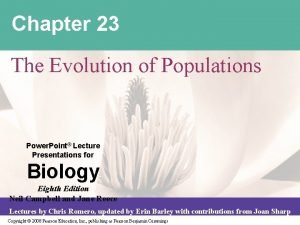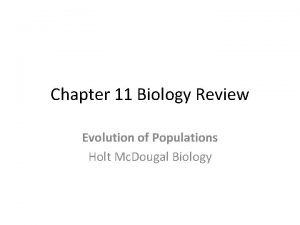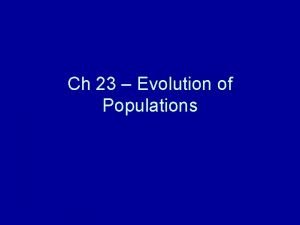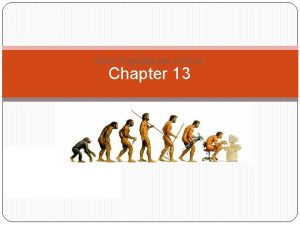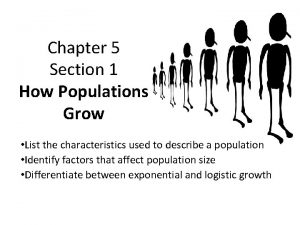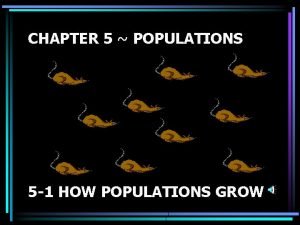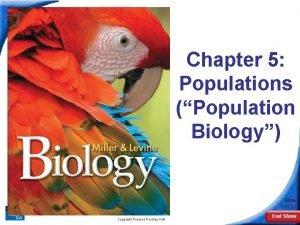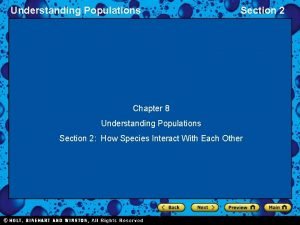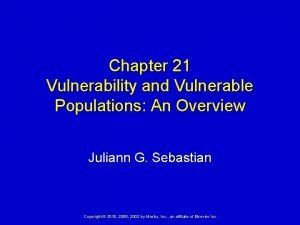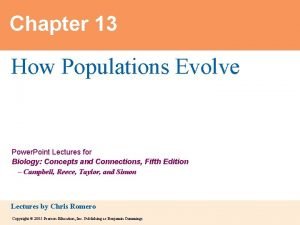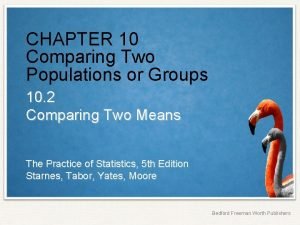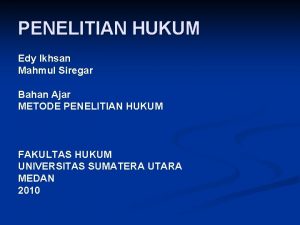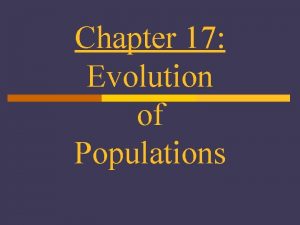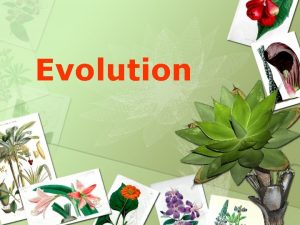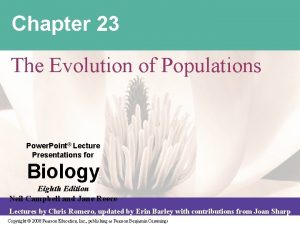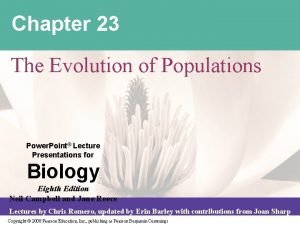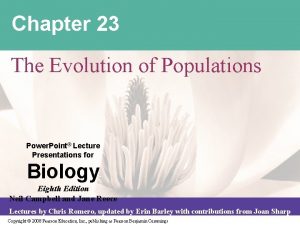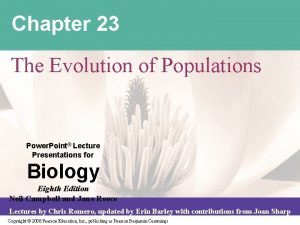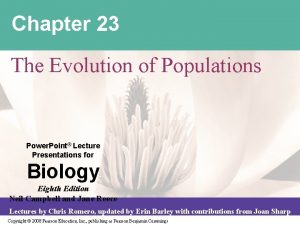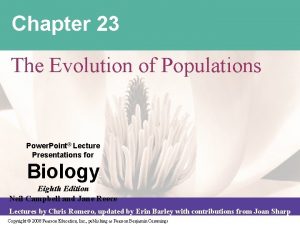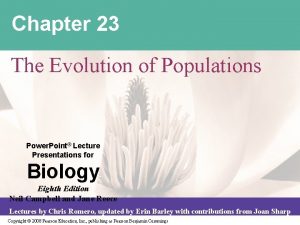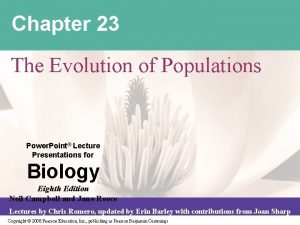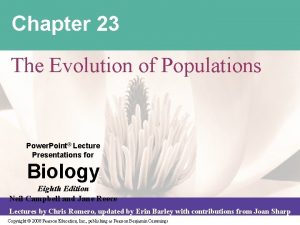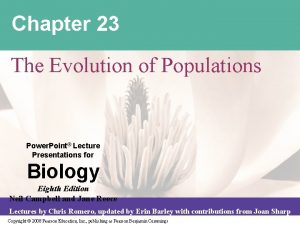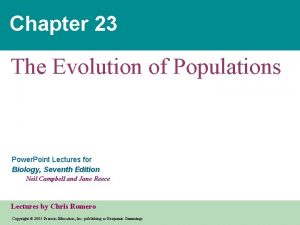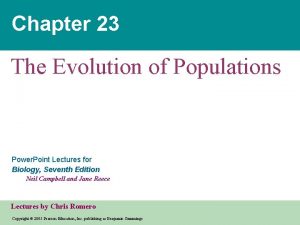Chapter 23 The Evolution of Populations Power Point





















































- Slides: 53

Chapter 23 The Evolution of Populations Power. Point Lectures for Biology, Seventh Edition Neil Campbell and Jane Reece Copyright © 2005 Pearson Education, Inc. publishing as Benjamin Cummings

Overview: The Smallest Unit of Evolution • Natural selection acts on individuals, but populations evolve • Genetic variations in populations contribute to evolution Figure 23. 1 Copyright © 2005 Pearson Education, Inc. publishing as Benjamin Cummings

Concept 23. 1: Population Genetics • Population genetics provides a foundation for studying evolution • Microevolution is change in the genetic makeup of a population from generation to generation Figure 23. 2 Copyright © 2005 Pearson Education, Inc. publishing as Benjamin Cummings

The Modern Synthesis • Population genetics – Is the study of how populations change genetically over time – Reconciled Darwin’s and Mendel’s ideas • The modern synthesis – Integrates Mendelian genetics with the Darwinian theory of evolution by natural selection – Focuses on populations as units of evolution Copyright © 2005 Pearson Education, Inc. publishing as Benjamin Cummings

Gene Pools and Allele Frequencies MAP AREA CANADA • The gene pool § Is the total aggregate of genes in a population at any one time ALASKA • A population is a localized group of individuals that are capable of interbreeding and producing fertile offspring Beaufort Sea Porcupine herd range N TE OR RR TH IT WE OR S IE T S • § Consists of all gene loci in all individuals of the population Fortymile herd range ALASKA YUKON Fairbanks • Whitehorse Figure 23. 3 Copyright © 2005 Pearson Education, Inc. publishing as Benjamin Cummings

The Hardy-Weinberg Theorem • The Hardy-Weinberg theorem – Describes a population that is not evolving – States that the frequencies of alleles and genotypes in a population’s gene pool remain constant from generation to generation provided that only Mendelian segregation and recombination of alleles are at work Copyright © 2005 Pearson Education, Inc. publishing as Benjamin Cummings

Mendelian inheritance • Mendelian inheritance preserves genetic variation in a population • Preservation of allele frequencies: In a given population where gametes contribute to the next generation randomly, allele frequencies will not change Generation 1 CWCW CRCR genotype Plants mate Generation 2 All CRCW (all pink flowers) 50% CR gametes Come together at random Generation 3 25% CRCR Ex. 50% CW gametes 50% CRCW 50% CR gametes 25% CWCW 50% CW gametes Come together at random Generation 4 25% CRCR 50% CRCW 25% CWCW Figure 23. 4 Copyright © 2005 Pearson Education, Inc. publishing as Benjamin Cummings Alleles segregate, and subsequent generations also have three types of flowers in the same proportions

Hardy-Weinberg Equilibrium • Hardy-Weinberg equilibrium – Describes a population in which random mating occurs – Describes a population where allele frequencies do not change Copyright © 2005 Pearson Education, Inc. publishing as Benjamin Cummings

Hardy-Weinberg Equilibrium • A population in Hardy-Weinberg equilibrium Gametes for each generation are drawn at random from the gene pool of the previous generation: 80% CR (p = 0. 8) 20% CW (q = 0. 2) Sperm CR (80%) CW (20%) pq CR (80%) p 2 64% CRCR CW (20%) Eggs p 2 16% CRCW qp 4% CWCW q 2 If the gametes come together at random, the genotype frequencies of this generation are in Hardy-Weinberg equilibrium: 64% CRCR, 32% CRCW, and 4% CWCW Gametes of the next generation: 16% CR from 64% CR from + CRCW homozygotes CRCR homozygotes 4% CW from homozygotes CWCW + 16% CW from CRCW heterozygotes = 80% CR = 0. 8 = p = 20% CW = 0. 2 = q With random mating, these gametes will result in the same mix of plants in the next generation: Figure 23. 5 64% CRCR, 32% CRCW and 4% CWCW plants Copyright © 2005 Pearson Education, Inc. publishing as Benjamin Cummings

Hardy-Weinberg Equilibrium • If p and q represent the relative frequencies of the only two possible alleles in a population at a particular locus, then – p 2 + 2 pq + q 2 = 1 – And p 2 and q 2 represent the frequencies of the homozygous genotypes and 2 pq represents the frequency of the heterozygous genotype Copyright © 2005 Pearson Education, Inc. publishing as Benjamin Cummings

Conditions for Hardy-Weinberg Equilibrium • The Hardy-Weinberg theorem – Describes a hypothetical population • In real populations – Allele and genotype frequencies do change over time Copyright © 2005 Pearson Education, Inc. publishing as Benjamin Cummings

Conditions for Hardy-Weinberg Equilibrium • The five conditions for non-evolving populations are rarely met in nature – Extremely large population size – No gene flow (no migration) – No mutations – Random mating – No natural selection Copyright © 2005 Pearson Education, Inc. publishing as Benjamin Cummings

Population Genetics and Human Health • We can use the Hardy-Weinberg equation – To estimate the percentage of the human population carrying the allele for an inherited disease Solving Hardy-Weinberg Problems Copyright © 2005 Pearson Education, Inc. publishing as Benjamin Cummings

Concept 23. 2: Mutation and Sexual recombination • Mutation and sexual recombination produce the variation that makes microevolution possible • Two processes, mutation and sexual recombination produce the variation in gene pools that contributes to differences among individuals Copyright © 2005 Pearson Education, Inc. publishing as Benjamin Cummings

Mutation • Mutations – Are changes in the nucleotide sequence of DNA – Cause new genes and alleles to arise Figure 23. 6 Copyright © 2005 Pearson Education, Inc. publishing as Benjamin Cummings

Point Mutations • A point mutation – Is a change in one base in a gene – Can have a significant impact on phenotype – Is usually harmless, but may have an adaptive impact Ex. http: //education-portal. com/cimages/multimages/16/missense_mutation 3. png Copyright © 2005 Pearson Education, Inc. publishing as Benjamin Cummings

Types of Point Mutations http: //upload. wikimedia. org/wikipedia/commons/6/69/Point_mutations-en. png Copyright © 2005 Pearson Education, Inc. publishing as Benjamin Cummings

Mutations That Alter Gene Number or Sequence • Chromosomal mutations that affect many loci – Are almost certain to be harmful – May be neutral and even beneficial • Gene duplication – Duplicates chromosome segments Copyright © 2005 Pearson Education, Inc. publishing as Benjamin Cummings

Table 2: Types of DNA Mutations and Their Impact Class of Mutation Type of Mutation Description Human Disease(s) Linked to This Mutation One base is incorrectly added during replication and Substitution replaces the pair in the corresponding position on the Sickle-cell anemia complementary strand Point mutation Insertion Deletion Inversion Deletion Chromosomal mutation Copy number variation One or more extra nucleotides are inserted into replicating DNA, often resulting in a frameshift One form of betathalassemia One or more nucleotides is "skipped" during replication or otherwise excised, often resulting in a Cystic fibrosis frameshift One region of a chromosome is flipped and Opitz-Kaveggia reinserted syndrome A region of a chromosome is lost, resulting in the Cri du chat syndrome absence of all the genes in that area Duplication A region of a chromosome is repeated, resulting in an increase in dosage from the genes in that region Some cancers Translocation A region from one chromosome is aberrantly attached to another chromosome One form of leukemia Gene The number of tandem copies of a locus is increased Some breast cancers amplification Expanding The normal number of repeated trinucleotide Fragile X syndrome, trinucleotide sequences is expanded Huntington's disease repeat http: //www. nature. com/scitable/topicpage/genetic-mutation-441 Copyright © 2005 Pearson Education, Inc. publishing as Benjamin Cummings

Mutation Rates • Mutation rates – Tend to be low in animals and plants – Average about one mutation in every 100, 000 genes per generation – Are more rapid in microorganisms Copyright © 2005 Pearson Education, Inc. publishing as Benjamin Cummings

Sexual Recombination • In sexually reproducing populations, sexual recombination – Is far more important than mutation in producing the genetic differences that make adaptation possible Why? Copyright © 2005 Pearson Education, Inc. publishing as Benjamin Cummings

Concept 23. 3: Altering Genetic Composition • Natural selection, genetic drift, and gene flow can alter a population’s genetic composition • Three major factors alter allele frequencies and bring about most evolutionary change – Natural selection – Genetic drift • Bottleneck effect • Founder effect – Gene flow Copyright © 2005 Pearson Education, Inc. publishing as Benjamin Cummings

Natural Selection • Differential success in reproduction – Results in certain alleles being passed to the next generation in greater proportions Ex. Copyright © 2005 Pearson Education, Inc. publishing as Benjamin Cummings

Genetic Drift • Statistically, the smaller a sample the greater the chance of deviation from a predicted result • Genetic drift describes how allele frequencies can fluctuate unpredictably from one generation to the next – Tends to reduce genetic variation CW CW CRCR Only 5 of 10 plants leave offspring CRCW CW CW CRCR CRCW CRCR CW CW CRCR CRCW Generation 1 p (frequency of CR) = 0. 7 q (frequency of CW) = 0. 3 CRCR CRCR CRCW Generation 2 p = 0. 5 q = 0. 5 Figure 23. 7 Copyright © 2005 Pearson Education, Inc. publishing as Benjamin Cummings Only 2 of 10 plants leave offspring CRCR Generation 3 p = 1. 0 q = 0. 0

The Bottleneck Effect • In the bottleneck effect – A sudden change in the environment may drastically reduce the size of a population – The gene pool may no longer be reflective of the original population’s gene pool (a) Shaking just a few marbles through the narrow neck of a bottle is analogous to a drastic reduction in the size of a population after some environmental disaster. By chance, blue marbles are over-represented in the new population and gold marbles are absent. Original population Figure 23. 8 A Copyright © 2005 Pearson Education, Inc. publishing as Benjamin Cummings Bottlenecking event Surviving population

The Bottleneck Effect • Understanding the bottleneck effect can increase understanding of how human activity affects other species Similarly, bottlenecking a (b) population of organisms tends to reduce genetic variation, as in these northern elephant seals in California that were once hunted nearly to extinction. Figure 23. 8 B http: //biology. gsu. edu/houghton/2107%20'08/Figures/Chapter 22/bottleneck. jpg Copyright © 2005 Pearson Education, Inc. publishing as Benjamin Cummings

The Founder Effect • The founder effect – Occurs when a few individuals become isolated from a larger population – Can affect allele frequencies in a population Copyright © 2005 Pearson Education, Inc. publishing as Benjamin Cummings

Examples of the Founder Effect http: //educationportal. com/cimages/multimages/16/Hartsock_Biology_Founder_Effect_ Goat_Cartoon. png Copyright © 2005 Pearson Education, Inc. publishing as Benjamin Cummings http: //www. cancer. gov/Published. Content/Images/cancertopics/understandingc ancer/cancergenomics/cancer 37. jpg

Gene Flow • Gene flow – Causes a population to gain or lose alleles – Results from the movement of fertile individuals or gametes – Tends to reduce differences between populations over time Copyright © 2005 Pearson Education, Inc. publishing as Benjamin Cummings

Example of Gene Flow http: //upload. wikimedia. org/wikipedia/commons/4/47/Gene_flow_final. png Copyright © 2005 Pearson Education, Inc. publishing as Benjamin Cummings

Concept 23. 4: Natural selection & Adaptive Evolution • Natural selection is the primary mechanism of adaptive evolution • Natural selection – Accumulates and maintains favorable genotypes in a population Copyright © 2005 Pearson Education, Inc. publishing as Benjamin Cummings

Genetic Variation • Genetic variation – Occurs in individuals in populations of all species – Is not always heritable (a) Map butterflies that emerge in spring: orange and brown (b) Map butterflies that emerge in late summer: black and white Figure 23. 9 A, B Copyright © 2005 Pearson Education, Inc. publishing as Benjamin Cummings

Variation Within a Population • Both discrete and quantitative characters – Contribute to variation within a population • Discrete characters – Can be classified on an either-or basis Ex. • Quantitative characters – Vary along a continuum within a population Ex. Copyright © 2005 Pearson Education, Inc. publishing as Benjamin Cummings

Variation Within a Population • Polymorphism • Phenotypic polymorphism – Describes a population in which two or more distinct morphs for a character are each represented in high enough frequencies to be readily noticeable • Genetic polymorphisms – Are the heritable components of characters that occur along a continuum in a population Copyright © 2005 Pearson Education, Inc. publishing as Benjamin Cummings

Variation Within a Population • Measuring Genetic Variation • Population geneticists – Measure the number of polymorphisms in a population by determining the amount of heterozygosity at the gene level and the molecular level • Average heterozygosity – Measures the average percent of loci that are heterozygous in a population Copyright © 2005 Pearson Education, Inc. publishing as Benjamin Cummings

Variation Between Populations • Most species exhibit geographic variation – Differences between gene pools of separate populations or population subgroups Figure 23. 10 1 2. 4 3. 14 5. 18 8. 11 9. 12 10. 16 13. 17 1 2. 19 3. 8 4. 16 9. 10 11. 12 13. 17 15. 18 Copyright © 2005 Pearson Education, Inc. publishing as Benjamin Cummings 6 7. 15 19 XX 5. 14 6. 7 XX

Variation Between Populations • Some examples of geographic variation occur as a cline, which is a graded change in a trait along a geographic axis Heights of yarrow plants grown in common garden Researchers observed that the average size of yarrow plants (Achillea) growing on the slopes of the Sierra Nevada mountains gradually decreases with increasing elevation. To eliminate the effect of environmental differences at different elevations, researchers collected seeds from various altitudes and planted them in a common garden. They then measured the heights of the resulting plants. Mean height (cm) EXPERIMENT Atitude (m) RESULTS The average plant sizes in the common garden were inversely correlated with the altitudes at which the seeds were collected, although the height differences were less than in the plants’ natural environments. CONCLUSION The lesser but still measurable clinal variation in yarrow plants grown at a common elevation demonstrates the role of genetic as well as environmental differences. Figure 23. 11 Copyright © 2005 Pearson Education, Inc. publishing as Benjamin Cummings Sierra Nevada Range Great Basin Plateau Seed collection sites

A Closer Look at Natural Selection • From the range of variations available in a population – Natural selection increases the frequencies of certain genotypes, fitting organisms to their environment over generations Copyright © 2005 Pearson Education, Inc. publishing as Benjamin Cummings

Evolutionary Fitness • The phrases “struggle for existence” and “survival of the fittest” – Are commonly used to describe natural selection – Can be misleading • Reproductive success – Is generally more subtle and depends on many factors Copyright © 2005 Pearson Education, Inc. publishing as Benjamin Cummings

Evolutionary Fitness • Fitness – Is the contribution an individual makes to the gene pool of the next generation, relative to the contributions of other individuals • Relative fitness – Is the contribution of a genotype to the next generation as compared to the contributions of alternative genotypes for the same locus Copyright © 2005 Pearson Education, Inc. publishing as Benjamin Cummings

Directional, Disruptive, and Stabilizing Selection • Selection favors certain genotypes by acting on the phenotypes of certain organisms • Three modes of selection are – Directional – Disruptive – Stabilizing Copyright © 2005 Pearson Education, Inc. publishing as Benjamin Cummings

Three Modes of Selection • Directional selection – Favors individuals at one end of the phenotypic range • Disruptive selection – Favors individuals at both extremes of the phenotypic range • Stabilizing selection – Favors intermediate variants and acts against extreme phenotypes Copyright © 2005 Pearson Education, Inc. publishing as Benjamin Cummings

Frequency of individuals Three Modes of Selection Original population Phenotypes (fur color) Evolved population (a) Directional selection shifts the overall makeup of the population by favoring variants at one extreme of the distribution. In this case, darker mice are favored because they live among dark rocks and a darker fur color conceals them from predators. (b) Disruptive selection favors variants at both ends of the distribution. These mice have colonized a patchy habitat made up of light and dark rocks, with the result that mice of an intermediate color are at a disadvantage. Fig 23. 12 A–C Copyright © 2005 Pearson Education, Inc. publishing as Benjamin Cummings (c) Stabilizing selection removes extreme variants from the population and preserves intermediate types. If the environment consists of rocks of an intermediate color, both light and dark mice will be selected against.

The Preservation of Genetic Variation • Various mechanisms help to preserve genetic variation in a population • Diploidy maintains genetic variation in the form of hidden recessive alleles • Balancing selection – Occurs when natural selection maintains stable frequencies of two or more phenotypic forms in a population – Leads to a state called balanced polymorphism Copyright © 2005 Pearson Education, Inc. publishing as Benjamin Cummings

Heterozygote Advantage • Some individuals who are heterozygous at a particular locus – Have greater fitness than homozygotes • Natural selection – Will tend to maintain two or more alleles at that locus Copyright © 2005 Pearson Education, Inc. publishing as Benjamin Cummings

Example of Heterozygote Advantage • The sickle-cell allele – Causes mutations in hemoglobin but also confers malaria resistance – Exemplifies the heterozygote advantage Distribution of malaria caused by Plasmodium falciparum (a protozoan) Figure 23. 13 Copyright © 2005 Pearson Education, Inc. publishing as Benjamin Cummings Frequencies of the sickle-cell allele 0– 2. 5% 2. 5– 5. 0% 5. 0– 7. 5% 7. 5– 10. 0% 10. 0– 12. 5% >12. 5%

Neutral Variation • Neutral variation – Is genetic variation that appears to confer no selective advantage Copyright © 2005 Pearson Education, Inc. publishing as Benjamin Cummings

Sexual Selection • Sexual selection – Is natural selection for mating success – Can result in sexual dimorphism, marked differences between the sexes in secondary sexual characteristics Copyright © 2005 Pearson Education, Inc. publishing as Benjamin Cummings

Intrasexual selection • Intrasexual selection – Is a direct competition among individuals of one sex for mates of the opposite sex Copyright © 2005 Pearson Education, Inc. publishing as Benjamin Cummings

Intersexual selection • Intersexual selection – Occurs when individuals of one sex (usually females) are choosy in selecting their mates from individuals of the other sex – May depend on the showiness of the male’s appearance Birds of Paradise Figure 23. 15 Copyright © 2005 Pearson Education, Inc. publishing as Benjamin Cummings

The Evolutionary Enigma of Sexual Reproduction • Sexual reproduction produces fewer reproductive offspring than asexual reproduction, a so-called reproductive handicap Sexual reproduction Asexual reproduction Generation 1 Female Generation 2 Male Generation 3 Generation 4 Figure 23. 16 Copyright © 2005 Pearson Education, Inc. publishing as Benjamin Cummings

Enigma of Sexual Reproduction • If sexual reproduction is a handicap, why has it persisted? – It produces genetic variation that may aid in disease resistance Copyright © 2005 Pearson Education, Inc. publishing as Benjamin Cummings

Why Natural Selection Cannot Fashion Perfect Organisms • Evolution is limited by historical constraints • Adaptations are often compromises • Chance and natural selection interact • Selection can only edit existing variations Copyright © 2005 Pearson Education, Inc. publishing as Benjamin Cummings
 Chapter 16 evolution of populations vocabulary review
Chapter 16 evolution of populations vocabulary review Chapter 17 evolution of populations answer key
Chapter 17 evolution of populations answer key Chapter 23 the evolution of populations
Chapter 23 the evolution of populations Section 16-1 genes and variation
Section 16-1 genes and variation Chapter 23 the evolution of populations
Chapter 23 the evolution of populations Stabilizing selection human birth weight
Stabilizing selection human birth weight Evolution of populations section 16-1 genes and variation
Evolution of populations section 16-1 genes and variation Evolution of populations section 11 review
Evolution of populations section 11 review Why are populations the smallest unit of evolution
Why are populations the smallest unit of evolution Real power and reactive power
Real power and reactive power Power bi training powerpoint
Power bi training powerpoint Point point power
Point point power Chapter 13 how populations evolve test
Chapter 13 how populations evolve test 5-1 how populations grow
5-1 how populations grow 5-1 how populations grow
5-1 how populations grow Chapter 10 comparing two populations or groups answer key
Chapter 10 comparing two populations or groups answer key 5-1 how populations grow
5-1 how populations grow Chapter 8 understanding populations
Chapter 8 understanding populations Chapter 21 vulnerability and vulnerable populations
Chapter 21 vulnerability and vulnerable populations Chapter 13 how populations evolve
Chapter 13 how populations evolve Chapter 10 comparing two populations or groups
Chapter 10 comparing two populations or groups The evolution of attorney by darrell news - dirga point
The evolution of attorney by darrell news - dirga point Hình ảnh bộ gõ cơ thể búng tay
Hình ảnh bộ gõ cơ thể búng tay Ng-html
Ng-html Bổ thể
Bổ thể Tỉ lệ cơ thể trẻ em
Tỉ lệ cơ thể trẻ em Voi kéo gỗ như thế nào
Voi kéo gỗ như thế nào Tư thế worm breton là gì
Tư thế worm breton là gì Hát lên người ơi alleluia
Hát lên người ơi alleluia Môn thể thao bắt đầu bằng từ đua
Môn thể thao bắt đầu bằng từ đua Thế nào là hệ số cao nhất
Thế nào là hệ số cao nhất Các châu lục và đại dương trên thế giới
Các châu lục và đại dương trên thế giới Cong thức tính động năng
Cong thức tính động năng Trời xanh đây là của chúng ta thể thơ
Trời xanh đây là của chúng ta thể thơ Mật thư tọa độ 5x5
Mật thư tọa độ 5x5 Làm thế nào để 102-1=99
Làm thế nào để 102-1=99 độ dài liên kết
độ dài liên kết Các châu lục và đại dương trên thế giới
Các châu lục và đại dương trên thế giới Thể thơ truyền thống
Thể thơ truyền thống Quá trình desamine hóa có thể tạo ra
Quá trình desamine hóa có thể tạo ra Một số thể thơ truyền thống
Một số thể thơ truyền thống Bàn tay mà dây bẩn
Bàn tay mà dây bẩn Vẽ hình chiếu vuông góc của vật thể sau
Vẽ hình chiếu vuông góc của vật thể sau Biện pháp chống mỏi cơ
Biện pháp chống mỏi cơ đặc điểm cơ thể của người tối cổ
đặc điểm cơ thể của người tối cổ Thế nào là giọng cùng tên?
Thế nào là giọng cùng tên? Vẽ hình chiếu đứng bằng cạnh của vật thể
Vẽ hình chiếu đứng bằng cạnh của vật thể Fecboak
Fecboak Thẻ vin
Thẻ vin đại từ thay thế
đại từ thay thế điện thế nghỉ
điện thế nghỉ Tư thế ngồi viết
Tư thế ngồi viết Diễn thế sinh thái là
Diễn thế sinh thái là Dạng đột biến một nhiễm là
Dạng đột biến một nhiễm là




